Catalogue > List by artist
Browse the entire list of Rencontre Internationales artists since 2004. Use the alphabetical filter to refine your search. update in progress
Mike Olenick
Catalogue : 2020The Cure | Experimental fiction | hdv | color | 19:35 | USA | 2017
Mike Olenick
The Cure
Experimental fiction | hdv | color | 19:35 | USA | 2017
A mom cries, photos fly, cats spy, and bodies collide in this sci-fi soap opera about people who are desperately searching for ways to cure their fears of loneliness. Dad is dying, mom can’t sleep, and Nancy is determined to find a photograph so she can forget something that she saw. Linda relives a past trauma and fears what might happen while she is away from home. Meanwhile, her boyfriend Mark entertains a mysterious stranger, who is secretly conducting a deadly experiment.
Mike Olenick’s perverse films focus on memories, reproduction, appropriation, transformation, and forbidden desire. His films have screened at Slamdance, Fantasia International Film Festival, Fantastic Fest, Palm Springs ShortFest, Hamburg International Short Film Festival, and the World Wide Video Festival; streamed on MUBI; and won awards at the Slamdance, Ann Arbor, Big Muddy, and Chicago Underground film festivals. For nearly fifteen years Mike was a video editor in the Film/Video Studio residency program at the Wexner Center for the Arts. He’s worked as an editor on projects for Guy Maddin (including “Keyhole” and “The Forbidden Room”), the Quay Brothers, Sadie Benning, and Lucy Raven, among others. Since 2003 he has edited numerous films for Jennifer Reeder including “A Million Miles Away,” which screened at Sundance. He also edited her feature “Knives and Skin,” which premiered at the Berlin Film Festival and is distributed by IFC Midnight. Projects he has worked on as an editor are in the collections of MoMA, the Guggenheim, the Whitney, and the Tate. Mike has an MFA in Photography from the Cranbrook Academy of Art. In 2016 he was awarded a fellowship at the inaugural Shudder Labs.
Rosa Olivares
Jacco Olivier
Catalogue : 2007Calling | Animation | dv | color | 1:9 | Netherlands | 2005
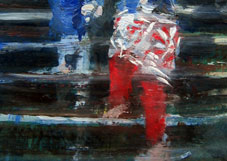
Jacco Olivier
Calling
Animation | dv | color | 1:9 | Netherlands | 2005
This animation is a succession of typical thriller and horror scenes: a black crow, an endlessly ringing telephone, creaking stairs, a shadow gliding past, a curtain flapping in the wind, and people walking the streets like zombies. All these elements seem to come together in a surrealistic ending. A shadow moves behind the window of a floating house. Was what we saw earlier perhaps the visualization of his thoughts? This is probably just one of the possible plots. Each viewer can construct a different story out of the available building blocks.
Catalogue : 2007Comfort | Experimental video | dv | color | 1:13 | Netherlands | 2005
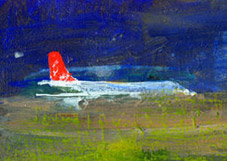
Jacco Olivier
Comfort
Experimental video | dv | color | 1:13 | Netherlands | 2005
The animation Comfort sheds light on the way Jacco Olivier works. The story that he originally has in mind is open to ideas that emerge during the creation process. In this way, an animation can eventually be built up out of various story lines. The various lines are woven together by rhyming imagery: from the red tail of a stationary Boeing, to the red Vodafone logo, and from there to a ringing red telephone. The animation also appears to be examining itself, when the camera suddenly dives into the deep and peels away the layers of a painting one by one, only to remerge at the top layer. Effortlessly the thread of the story is picked up again. In contrast to what the title suggests, an atmosphere of fear and oppression predominates in this work.
Erik Olofsen
Catalogue : 2008Public Figures | Experimental film | 0 | color | 10:22 | Netherlands, Belgium | 2007
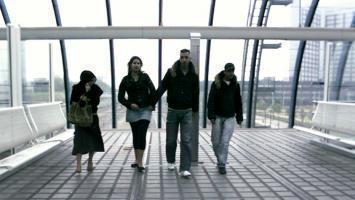
Erik Olofsen
Public Figures
Experimental film | 0 | color | 10:22 | Netherlands, Belgium | 2007
The film was shot using a digital high-speed camera from a moving metro car while entering a busy station. The result is an endless shot of people on a subway platform passing by in slow motion. The tranquil movement of the camera and stillness of the people portrayed, give room for a hypnotic chain of thoughts and associations. The platform seems to have transformed into a stage where everyday people`s small gestures and simple routines turn into a performance.
Born in The Netherlands, in 1970. His installation works have been shown in numerous countries, and usually involve different medias such as sculpture, architectural elements, video, photographs and sound. He also introduced new technology to his artistic work, including industrial robots and high-speed digital cameras. Was a resident at the Rijks Academy in Amsterdam, the Chinese European Art Centre in Xiamen, and Bilbao Arte. Prizes include winning the prestigious Dutch Prix de Rome with the installation ?Remotely Here?, the Spanish international prize Vidalife with the work ?Divine methods / Hidden motives? and the Media Forum prize at the Moscow International Film Festival with the video ?In Places?.
Arianne Olthaar
Catalogue : 2018Gesamtschule | Experimental film | 16mm | color | 5:23 | Netherlands | 2016
Arianne Olthaar
Gesamtschule
Experimental film | 16mm | color | 5:23 | Netherlands | 2016
Images of a comprehensive school in West Germany that was built between 1972 and 1978. At the time it was very modern and progressive, both in the way of its education as well in its interior design. An example is the integrated disco in the cellar where up untill today schoolchildren can dance during their lunch break.
Arianne Olthaar (1970, Netherlands) is making experimental films, photographs and miniature models. Her work has a strong focus on the once-luxurious interiors of public spaces that were built in the 1970s and 80s, such as primate enclosures, dining cars, hotel nightclubs, discotheques, a school interior. Interiors that once represented an explicit modern luxury but nowadays have an aura of faded glory and are increasingly disappearing by renovation or demolishment. Her work has been presented in a variety of exhibitions as well as numerous international film festivals, including Cinematexas; Media City Film and Video Festival, Windsor; International Short Film Festival Oberhausen; EMAF Osnabrück; New York Film Festival; Onion City Experimental Film and Video Festival, Chicago; VIDEOEX; Zürich, International Film Festival Rotterdam; Rencontres Internationales, Paris/Berlin.
Catalogue : 2017Hotel Forum | Video | hdv | color | 9:30 | Netherlands | 2016
Arianne Olthaar
Hotel Forum
Video | hdv | color | 9:30 | Netherlands | 2016
The film is inspired by the once huge and luxurious hotels in the former Eastern Bloc designed in the 1970s and 80s. In the meantime their glamour is considered out of date and most of the hotels have been shut down, renovated or demolished.
Arianne Olthaar (1970, Netherlands) graduated as a painter from the Hagues? Royal Academy of Art in 1992. She is making experimental films, photographs and miniature models. Her work has a strong focus on the once-luxurious interiors of public spaces, built in the 1970s and 80s (primate enclosures, dining cars, hotel nightclubs, discotheques, a school interior). Interiors that once represented an explicit modern luxury but nowadays have an aura of faded glory and are increasingly disappearing by renovation or demolishment. Her work has been presented in a variety of exhibitions as well as numerous international film festivals, including Cinematexas; Media City Film and Video Festival, Windsor; International Short Film Festival Oberhausen; European Media Art Festival, Osnabrück; New York Film Festival; Onion City Experimental Film and Video Festival, Chicago and International Film Festival Rotterdam.
I Oñederra
Catalogue : 2009HEZURBELTZAK, una fosa común | Animation | 35mm | black and white | 4:30 | Spain | 2007
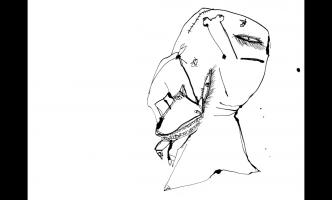
I OÑederra
HEZURBELTZAK, una fosa común
Animation | 35mm | black and white | 4:30 | Spain | 2007
The Basque word hezurbeltzak does not appear in dictionaries. It is a non-existing word used to describe socially invisible groups. Its literal translation would be ?black bones?.
Azkoitia, 1979. She got a degree in Fine Arts at the University of the Basque Country and she specialized in painting and in animation cinema. She wrote a thesis on the figure of the antihero and how it has been represented in contemporary art. She exhibits her work regularly with the Epelde-Mardaras gallery from Bilbao. She has organised animation workshops for children and nowadays, she took part in the Berbaoc animation project, which is coordinated by Isabel Herguera in the Arteleku centre in San Sebastian.
Hans Op De Beeck
Catalogue : 2016Night Time (extended) | Animation | hdv | black and white | 19:18 | Belgium | 2015
Hans Op De Beeck
Night Time (extended)
Animation | hdv | black and white | 19:18 | Belgium | 2015
"Night Time (extended)" - Hans Op de Beeck 2015 Full HD video, black and white, sound, 2015 (19 minutes 20 seconds) ‘Night time (extended)’ is a dark, enigmatic animation without text based on a large series of monumental monochrome watercolours which Op de Beeck steadily realised over the past five years, in between all his other multidisciplinary projects. All the watercolours were painted by the artist at night in complete solitude and concentration.This nightly atmosphere is a tangible presence in the metropolitan landscapes, the images of nature, the buildings, interiors and characters which the artist brings to life in the film. "Night time (extended)" is conceived as a mysterious dream in which all proportions, perspectives and environments are fictitious. In this way, intimate close-ups are made to alternate with sweeping images; every image clearly and visibly the product of deliberate construction. The film is comforting and soothing, yet also exudes a sense of dormant danger and derailment, just as in the film noir tradition. Here, Op de Beeck brings together an anachronistic whole of both classical and distinctly contemporary themes into an effortless blend of both highly cultivated and more visceral subcultural elements.
Hans Op de Beeck produces large installations, sculptures, films, drawings, paintings, photographs and texts. His work is a reflection on our complex society and the universal questions of meaning and mortality that resonate within it. He regards man as a being who stages the world around him in a tragi-comic way. Above all, Op de Beeck is keen to stimulate the viewers’ senses, and invite them to really experience the image. He seeks to create a form of visual fiction that delivers a moment of wonder and silence. Over the past fifteen years Op de Beeck realized numerous monumental ‘sensorial’ installations, in which he evoked what he describes as ‘visual fictions’: tactile deserted spaces as an empty set for the viewer to walk through or sit down in, sculpted havens for introspection. In many of his films though, in contrast with those depopulated spaces, he prominently depicts anonymous characters. Hans Op de Beeck was born in Turnhout in 1969. He lives and works in Brussels and Gooik, Belgium. Op de Beeck has shown his work extensively in solo and group exhibitions around the world. He had substantial institutional solo shows at the GEM Museum of Contemporary Art of The Hague, The Hague, NL (2004); MUHKA Museum of Contemporary Art, Antwerp, B (2006); Centraal Museum, Utrecht, NL (2007); the Smithsonian’s Hirshhorn Museum and Sculpture Garden, Washington DC, US (2010); KunstmuseumThun, CH (2010); Centro de Arte Caja de Burgos, Burgos, ES (2010); Butler Gallery, Kilkenny, IRL (2012); Kunstverein Hannover, D (2012); Tampa Museum of Art, Tampa, USA (2013); the Harn Museum of Art, Gainesville, FL, USA (2013); FRAC Paca, Marseille, F (2013); MIT List Visual Arts Center, Cambridge, Boston MA, US (2014); MOCA Cleveland, OH, US (2014); Sammlung Goetz, Munich, D (2014), … Op de Beeck participated in numerous group shows at institutions such as The Reina Sofia, Madrid, ES; the Scottsdale Museum of Contemporary Art, AZ, US; the Towada Art Center, Towada, JP; ZKM, Karlsruhe, DE; MACRO, Rome, IT; the Whitechapel Art Gallery, London, GB; PS1, New York, NY, US; Musée National d’ArtModerne, Centre Pompidou, Paris, FR; Wallraf-Richartz Museum, Köln, DE; Hangar Bicocca, Milano, IT; the Hara Museum of Contemporary Art, Tokyo, JP; 21C Museum, Louisville, Kentucky, US; The Drawing Center, New York, NY, US; Kunsthalle Wien, Vienna, AT; Shanghai Art Museum, Shanghai, CN; MAMBA, Buenos Aires, AR; Haus der Kunst, Munich, DE; Museod’ArteModerna di Bologna, Bologna, IT; Kunstmuseum Bonn, Bonn DE, … His work was invited for the Venice Biennale, Venice, IT; the Shanghai Biennale, Shanghai, CN; the Aichi Triennale, Aichi, JP; the Singapore Biennale, Singapore, SG; Art Summer University, Tate Modern, London, GB; the Kochi-Muziris Biennale, IN, and many other art events.
Hans Op De Beeck
Catalogue : 2014Staging Silence (2) | Experimental video | | black and white | 20:48 | Belgium | 2013
Hans Op De Beeck
Staging Silence (2)
Experimental video | | black and white | 20:48 | Belgium | 2013
Hans Op de Beeck`s film `Staging Silence (2)` is based around abstract, archetypal settings that lingered in the memory of the artist as the common denominator of the many similar public places he has experienced. The video images themselves are both ridiculous and serious, just like the eclectic mix of pictures in our minds. The decision to film in black and white heightens this ambiguity: the theatre like approach of the video invokes the legacy of slapstick, as well as the insidious suspense and latent derailment of film noir. The title refers to the staging of such dormant decors where, in the absence of people, the spectator can project himself as the lone protagonist. Memory images are disproportionate mixtures of concrete information and fantasies, and in this film they materialise before the spectator`s eyes through anonymous tinkering and improvising hands. Arms and hands appear and disappear at random, manipulating banal objects, scale representations and artificial lighting into alienating yet recognisable locations. These places are no more or less than animated decors for possible stories, evocative visual propositions to the spectator. Op de Beeck`s film is accompanied by a score which, inspired by the images themselves, has been composed by composer-musician Scanner (UK).
Hans Op de Beeck Situating the artist and his oeuvre Visual artist Hans Op de Beeck lives and works in Brussels, where he has developed his career through international exhibitions over the past ten years. His work consists of sculptures, installations, video work, photography, animated films, drawings, paintings and writing (short stories). It is his quest for the most effective way of presenting the concrete contents of each work that determines the medium that the artist ultimately selects. The scale can vary from the size of a small watercolour to a large, three-dimensional installation of 300m2. The artist not only uses a very wide variety of media, but also deliberately employs a diversity of aesthetic forms, ranging from an economical, minimalist visual language to overloaded, exaggerated designs, always with the aim of articulating the content of the work as precisely as possible. Thematically, the work concentrates on our laborious and problematic relationship with time, space and each other. Op de Beeck shows the viewer non-existent, but identifiable places, moments and characters that appear to have been taken from contemporary everyday life, aiming thereby to capture in his images the tragicomic absurdity of our postmodern existence. Key themes are the disappearance of distances, the disembodiment of the individual and the abstraction of time that have resulted from globalisation and the changes to our living environment that developments in media, automation and technology have brought about. Hans Op de Beeck sometimes calls his works ?proposals?; they are irrefutably fictional, constructed and staged, leaving it up to the viewer whether to take the work seriously, as a sort of parallel reality, or immediately to put it into perspective, as no more than a visual construct. His work is nourished by a keen interest in social and cultural reflection. The artist also questions the difficult relationship between reality and representation, between what we see and what we want to believe, between what is and what we create for ourselves in order to make it easier to deal with our own insignificance and lack of identity. The visual output of that investigation often produces slumbering, insidious, melancholy and astonishing images.
Hans Op De Beeck
Catalogue : 2018The Girl | Experimental film | hdv | color | 16:0 | Belgium | 2017
Hans Op De Beeck
The Girl
Experimental film | hdv | color | 16:0 | Belgium | 2017
"The Girl" is a slow, suggestive, perception-oriented animated film in which the viewer is transported to the strange world of a silent, 14-year-old girl. The dreamy landscape images show a dark forest, a vast landfill, a gas station, a highway landscape, a meadow, a factory site and a mysterious lake. Amidst all this stands an old caravan. The scene seems to suggest that the protagonist leads a lonely life on these premises. For a further unspecified reason, she must at one time have left her parental home, which is presented to us at the beginning of the film, both in perfect condition, and later in a neglected, abandoned state. In a variety of different landscapes, we see the girl perform small acts such as gather usable waste or pick herbs. We often get to see her cargo bike; the vehicle she uses to gather the bear necessities in order to survive. Nighttime, breaking dawn, wind, rain, fog, cold and warming fire are present throughout the film. Occasionally, we get to see the girl “resting serenely” from up close, as if we were right beside her, and could feel her breath. At the end of the film we understand that she is resting on a raft in the lake, floating, passive, as a metaphor for surrender. An original soundtrack for the film was composed by Tom Pintens, on a text by the artist.
Hans Op de Beeck produces large installations, sculptures, films, drawings, paintings, photographs and texts. His work is a reflection on our complex society and the universal questions of meaning and mortality that resonate within it. He regards man as a being who stages the world around him in a tragi-comic way. Above all, Op de Beeck is keen to stimulate the viewer’s senses, and invite them to really experience the image. He seeks to create a form of visual fiction that delivers a moment of wonder and silence. Over the past twenty years Op de Beeck realized numerous monumental “ sensorial ” installations, in which he evoked what he describes as “ visual fictions ”: tactile deserted spaces as an empty set for the viewer to walk through or sit down in, sculpted havens for introspection. In many of his films though, in contrast with those depopulated spaces, he prominently depicts anonymous characters. Hans Op de Beeck was born in Turnhout in 1969. He lives and works in Brussels and Gooik, Belgium. Op de Beeck has shown his work extensively in solo and group exhibitions around the world.
Hans Op De Beeck
Catalogue : 2012Sea of Tranquillity | Video | | color | 29:50 | Belgium | 2010
Hans Op De Beeck
Sea of Tranquillity
Video | | color | 29:50 | Belgium | 2010
The medium-length film `Sea of Tranquillity` is a combination of live video recordings of actors and digitally-generated 3D environments in which the viewer makes a night-time visit to a mysterious, mythical cruise liner, the `Sea of Tranquillity`. This fictitious cruise liner has been designed by Hans Op de Beeck, following a short residence at Saint-Nazaire in France in 2008, during which the artist became intrigued by the remarkable Second World War story and postwar reconstruction of this harbour town, whose shipyards produce the worlds largest cruise liners. It seemed to the artist that the Queen Mary 2, then just completed, was, like the Burj Khalifa in Dubai (the highest building in the world), a suitable metaphor for our belief in spurious values and in such concepts as work, leisure time and luxury consumerism. We nowadays use such categories as the highest, the first and the biggest, but what do these terms say about the actual quality of things?
Visual artist Hans Op de Beeck lives and works in Brussels, where he has developed his career through international exhibitions over the past ten years. His work consists of sculptures, installations, video work, photography, animated films, drawings, paintings and writing (short stories). It is his quest for the most effective way of presenting the concrete contents of each work that determines the medium that the artist ultimately selects. The scale can vary from the size of a small watercolour to a large, three-dimensional installation of 300m2. The artist not only uses a very wide variety of media, but also deliberately employs a diversity of aesthetic forms, ranging from an economical, minimalist visual language to overloaded, exaggerated designs, always with the aim of articulating the content of the work as precisely as possible. Thematically, the work concentrates on our laborious and problematic relationship with time, space and each other. Op de Beeck shows the viewer non-existent, but identifiable places, moments and characters that appear to have been taken from contemporary everyday life, aiming thereby to capture in his images the tragicomic absurdity of our postmodern existence. Key themes are the disappearance of distances, the disembodiment of the individual and the abstraction of time that have resulted from globalisation and the changes to our living environment that developments in media, automation and technology have brought about. Hans Op de Beeck sometimes calls his works "proposals"; they are irrefutably fictional, constructed and staged, leaving it up to the viewer whether to take the work seriously, as a sort of parallel reality, or immediately to put it into perspective, as no more than a visual construct. His work is nourished by a keen interest in social and cultural reflection. The artist also questions the difficult relationship between reality and representation, between what we see and what we want to believe, between what is and what we create for ourselves in order to make it easier to deal with our own insignificance and lack of identity. The visual output of that investigation often produces slumbering, insidious, melancholy and astonishing images.
Catalogue : 2010Staging Silence | Video | dv | black and white | 22:0 | Belgium | 2009
Hans Op De Beeck
Staging Silence
Video | dv | black and white | 22:0 | Belgium | 2009
?Staging Silence? is based around remembered spaces; not any specific sites, but the abstract, archetypal settings that lingered in my memory as the common denominator of the many similar public places I have visited and experienced. The video images themselves are both ridiculous and serious, just like the eclectic mix of pictures in our minds. The decision to film in black-and-white heightens this ambiguity: the amateurish quality of the video invokes the legacy of slapstick, as well as the insidious suspense and latent derailment of film noir. But perhaps gravity and menace ultimately prevail. The title, ?staging silence?, refers to the staging of such dormant decors where, in the absence of people, the spectator can project himself as the lone protagonist, unhindered by others. Memory images are disproportionate mixtures of concrete information and fantasies, and in this film they materialize before the spectator?s eyes through anonymous tinkering and improvising hands. Arms, like those of faceless puppeteers, appear and disappear at random, manipulating banal objects, scale representations and artificial lighting into alienating yet recognizable locations. These places are no more or less than animated decors for possible stories, evocative visual propositions to the spectator. The film is accompanied by a score which, inspired by the images themselves, has been composed and performed by composer-musician Serge Lacroix.
Visual artist Hans Op de Beeck lives and works in Brussels, where he has developed his career through international exhibitions over the past ten years. His work consists of sculptures, installations, video work, photography, animated films, drawings, paintings and writing (short stories). It is his quest for the most effective way of presenting the concrete contents of each work that determines the medium that the artist ultimately selects. The scale can vary from the size of a small watercolour to a large, three-dimensional installation of 300m2. The artist not only uses a very wide variety of media, but also deliberately employs a diversity of aesthetic forms, ranging from an economical, minimalist visual language to overloaded, exaggerated designs, always with the aim of articulating the content of the work as precisely as possible. Thematically, the work concentrates on our laborious and problematic relationship with time, space and each other. Op de Beeck shows the viewer non-existent, but identifiable places, moments and characters that appear to have been taken from contemporary everyday life, aiming thereby to capture in his images the tragicomic absurdity of our postmodern existence. Key themes are the disappearance of distances, the disembodiment of the individual and the abstraction of time that have resulted from globalisation and the changes to our living environment that developments in media, automation and technology have brought about. Hans Op de Beeck sometimes calls his works "proposals"; they are irrefutably fictional, constructed and staged, leaving it up to the viewer whether to take the work seriously, as a sort of parallel reality, or immediately to put it into perspective, as no more than a visual construct. His work is nourished by a keen interest in social and cultural reflection. The artist also questions the difficult relationship between reality and representation, between what we see and what we want to believe, between what is and what we create for ourselves in order to make it easier to deal with our own insignificance and lack of identity. The visual output of that investigation often produces slumbering, insidious, melancholy and astonishing images.
Catalogue : 2008The stewarts have a party | Experimental video | dv | color | 4:19 | Belgium | 2007
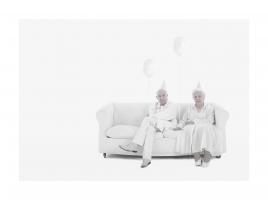
Hans Op De Beeck
The stewarts have a party
Experimental video | dv | color | 4:19 | Belgium | 2007
?The Stewarts? are a fictitious and carefully cast family. The various family members appear and disappear in an empty white room, like life-sized marionettes dressed in white. As is customary in this subgenre of marionette theatre, they are manipulated by puppeteers dressed in black; consisting in this case of the set entourage: production assistants, a makeup girl and a hair stylist. The family members are moved to spots in the space and tidied up for their performance. Finally the puppeteers/assistants strap balloons to ?The Stewarts? and place cardboard party hats on their heads. All of this takes place calmly and in complete silence, none of the Stewarts shows a sign of emotion.
Hans Op de Beeck (BE, 1969) studied at the Hogeschool Sint-Lukas, Brussels and the Rijksacademie, Amsterdam. As a multi-disciplinary artist he makes use of various media, like video, installations, sculptural work, photography, text, animation and sketches. He adapts his medium to the chosen thematic, always searching for some kind of parallel world, an ageless nowhere. The world as it is presented here is an uncanny no man?s land, in which there is hardly room for human beings. Op de Beeck is looking for a ?being in transit?, an in-between, seemingly reason-less entity: the unrestrained, the chaos of the undefi ned. Op de Beeck has exhibited at the Fondazione Bevilacqua La Masa (Venice), GEM (The Hague) and Xavier Hufkens (Brussels). In 2001 he won the Young Belgian Painting Award, in 2006 the Prize Eugène Baie.
Catalogue : 2008The Building | Art vidéo | dv | color | 4:19 | Belgium | 2007
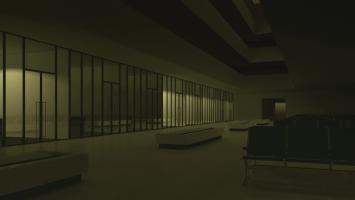
Hans Op De Beeck
The Building
Art vidéo | dv | color | 4:19 | Belgium | 2007
"The Building" is a digitally generated animation movie in which the artist sends the viewer on a virtual, nocturnal walking tour of a fictitious, megalomaniacal hospital complex. This hospital has the same mediocre, half-hearted, over-the-top architectural features as the hospitals, shopping malls, health clubs, and airports that have shot up like mushrooms all over the Western world. These buildings are designed to accommodate thousands of visitors. They radiate a mood of alienation and interchangeability. Strikingly enough, these impersonal hospital complexes usually form the backdrop to the most personal and essential moments in life: in a hospital one is born, suffers, comforts, heals, and dies. "The Building" does not follow a strict narrative line, rather it submerses the viewer in the slumbering, nocturnal machine, with the camera switching back and forth between a neutral, observational point of view and the subjective position of the patient.
Hans Op de Beeck (°1969, Turnhout, Belgium) Lives and works in Brussels (Belgium) www.hansopdebeeck.com SELECTION OF SOLO-EXHIBITIONS AND PROJECTS 2007 Hans Op de Beeck: Extensions M, Louvain Hans Op de Beeck: Extensions Centraal Museum, Utrecht Hans Op de Beeck: Merry-go-round (2) Art Unlimited, Basel Hans Op de Beeck: Extensions Galleria Continua, San Gimignano Hans Op de Beeck: All together now... Galerie Ron Mandos, Amsterdam 2006 Hans Op de Beeck: Family (scenes and scenery) Xavier Hufkens Gallery, Brussels Hans Op de Beeck: Tables... Galerie Krinzinger, Vienna Hans Op de Beeck: My Brother?s Gardens Fondazione Bevilacqua La Masa, Venice Hans Op de Beeck: Loss Viafarini, Milan 2005 Hans Op de Beeck: In their minds? Nicole Klagsbrun Gallery, New York Hans Op de Beeck: T-Mart MuHKA, Museum of Contemporary Art, Antwerp 2004 Hans Op de Beeck: Loss Galerie Les Filles du Calvaire, Paris Hans Op de Beeck: Location (5) Art Unlimited, Basel Hans Op de Beeck Galerie Ron Mandos, Rotterdam Hans Op de Beeck: Meanwhile? Museum of Contemporary Art, The Hague 2003 Hans Op de Beeck: My brother?s gardens Xavier Hufkens, Brussels 2001 Hans Op de Beeck Hales Gallery, London SELECTION OF GROUP-EXHIBITIONS 2008 Car Culture Scottsdale Museum of Contemporary Art, Arizona Discovering Slowness M?Ars - Centre of Contemporary Art, Moscow Variable Capital Bluecoat Arts Centre, Liverpool Towada Art Project (permanent installation of ?Location (5)?) Towada Art Center, Towada (JP) 2007 A Story of the Image: Visual Art as Visual Culture ICA, Singapore Dealing with Reality Museum of Modern Art, Arnhem (NL) La città che sale - We try to build the future ARCOS, Benevento (IT) - MACRO, Rome Imagination Becomes Reality (# 6) (Goetz Collection) ZKM, Karlsruhe (DE) Our Magic Hour ARARIO Gallery, Seoul The Leading Thread Centro de Arte Caja de Burgos (CAB), Burgos (ES) 2006 Rencontres Internationales Cinéma de l?Entrepôt, Paris - Cinema Babylon, Berlin - Circulo de Bellas Artes, Madrid Version Animée - Biennale des nouveaux médias Centre pour l?image contemporaine, Genève 6th Shanghai Biennale Shanghai Art Museum, Shanghai Fresh! Museum of Glass, Tacoma, Washington Animated Stories CaixaForum, Barcelona - Sala Rekalde, Bilbao - Le Fresnoy, Tourcoing (FR) Analog Animation 2006 The Drawing Center, New York 2005 NIGHT SITES Kunstverein Hannover, Hanover The MARTa Herford Collection MARTa, Herford En Attente Casino Luxembourg - forum d?art contemporain, Luxembourg Visionary Belgium (Harald Szeemann) Palais des Beaux-Arts, Brussels 2004 100 % Acid Free White Columns, New York All that useless beauty Whitechapel, Project Space, London 2003 Silent Wandering... Postbahnhof Am Ostbahnhof, Berlin Breaking Away P.S.1-MoMA, New York 2002 Printemps de Septembre (festival) Toulouse BIG Torino 2002, International Biennial of Young Art (Big Social Game) Torino
Catalogue : 2007All together now... | Experimental video | betaSP | color | 6:20 | Belgium | 2005
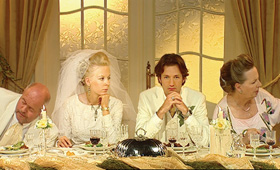
Hans Op De Beeck
All together now...
Experimental video | betaSP | color | 6:20 | Belgium | 2005
"All together now..." is a lively, tragicomic portrait of three groups of table-companions, portrayed on three different occasions: a group of people in their late seventies at a table, set rather soberly with coffee and cake after a funeral; a wistful bride and her bridegroom with their families in an over-decorated party center, and a birthday dinner for a well-to-do pater familias in an under-cooled design interior. These moments around a table may be some of clearest situations in which people gather together in a more or less artificial manner. Mutual grudges, unspoken feelings, and tensions between family members are hidden between the lines of the ritual. The camera slowly pans once along the people around the table. This six-minute choreography of actions in miniature, conversations, and knowing glances, clarifies the relationships around the table. Some of the characters are comic, others rather tragic or touching. Due to the slow-motion technique, every detail becomes outspokenly visible. "All together now..." is a contemporary portrait of human beings around the table, in which the sobering, post-party emptiness, can be sensed while the feast is still in progress.
The Belgian visual artist Hans Op de Beeck (Turnhout, 1969) creates huge, life-sized installations, imaginary urban sites on scale, video installations, sculptures, photos, drawings and animated films. He has for several years been involved in many individual projects and group shows in quick succession. His work has been shown throughout Europe and the United States. In 2002-2003 he was artist-in-residence at MoMA-PS. in New York. At Art Unlimited (Art Basel 2004) he showed a life-sized motorway restaurant, overlooking a nightly motorway. Recently he showed work at MARTa Herford, Kunstverein Hannover, MuHKA Antwerp, Casino Luxemburg, Shanghai Art Museum, PSK Brussels, GEM-Museum of Contemporary Art (The Hague), and The Drawing Center (New York).
Hans Op De Beeck
Catalogue : 2015Before the rain(a village) | Experimental doc. | hdv | color | 12:0 | Belgium, India | 2013
Hans Op De Beeck
Before the rain(a village)
Experimental doc. | hdv | color | 12:0 | Belgium, India | 2013
Before the Rain (A Village) shows us the daily events in this South Indian region, which combines a mineral, eroded landscape with rice fields, sheep herds and the impressive ruins of the Vijayanagara dynasty (1336-1565). During the rain season the artist stayed in the remote South Indian village, where humans and animals live together in small huts and sheds. He filmed only just before the onset of a new shower of rain—a time when the light becomes very diffuse and the sky becomes strangely, vaguely white. Oddly enough, as a result the Indian village bathes in a typically subdued, Western European light that is very unusual in the south of India. The film is constructed as a series of silent tableaux vivants that are filmed with a static, frontal camera on a tripod. Op de Beeck quite deliberately sought the small, everyday things we share beyond cultural borders, and consciously stayed away from the spectacular and that which is explicitly related to religion, mysticism or “being different”. Thus with this film he tried to create a sort of imaginary, universal village that speaks about how time silently passes in a small community, while avoiding the “exoticizing” glance of the idealizing idyll. The work invites a silent, sensory perception and reflection.
Hans Op de Beeck (° 1969 - Turnhout, Belgium) Lives and works in Brussels, Belgium Education/ Programs/ Awards 2009: Catholic University of Leuven Culture Prize 2009-2010 2006: Winner of the Prize Eugène Baie 2003-2005, Antwerp 2002-2003: Artist at the MoMA-P.S.1 Studio Program, New York 2001: Winner of the `Prix Jeune Peinture Belge 2001`, Palais des Beaux Arts, Brussels 1998-1999: Participant at the Rijksakademie, Amsterdam (post-MA) 1996-1997: Participant at The Higher Institute for Fine Arts-Flanders, Antwerp (post-MA) 1992-1996: Masters Degree in Visual Arts, Higher Institute Sint-Lukas, Brussels Situating the artist and his oeuvre Visual artist Hans Op de Beeck lives and works in Brussels, where he has developed his career through international exhibitions over the past ten years. His work consists of sculptures, installations, video work, photography, animated films, drawings, paintings and writing (short stories). It is his quest for the most effective way of presenting the concrete contents of each work that determines the medium that the artist ultimately selects. The scale can vary from the size of a small watercolour to a large, three-dimensional installation of 300m2. The artist not only uses a very wide variety of media, but also deliberately employs a diversity of aesthetic forms, ranging from an economical, minimalist visual language to overloaded, exaggerated designs, always with the aim of articulating the content of the work as precisely as possible. Thematically, the work concentrates on our laborious and problematic relationship with time, space and each other. Op de Beeck shows the viewer non-existent, but identifiable places, moments and characters that appear to have been taken from contemporary everyday life, aiming thereby to capture in his images the tragicomic absurdity of our postmodern existence. Key themes are the disappearance of distances, the disembodiment of the individual and the abstraction of time that have resulted from globalisation and the changes to our living environment that developments in media, automation and technology have brought about. Hans Op de Beeck sometimes calls his works "proposals"; they are irrefutably fictional, constructed and staged, leaving it up to the viewer whether to take the work seriously, as a sort of parallel reality, or immediately to put it into perspective, as no more than a visual construct. His work is nourished by a keen interest in social and cultural reflection. The artist also questions the difficult relationship between reality and representation, between what we see and what we want to believe, between what is and what we create for ourselves in order to make it easier to deal with our own insignificance and lack of identity. The visual output of that investigation often produces slumbering, insidious, melancholy and astonishing images.
Ana Opalic
Catalogue : 2010PISMO | Video | dv | color | 7:22 | Croatia | 2009
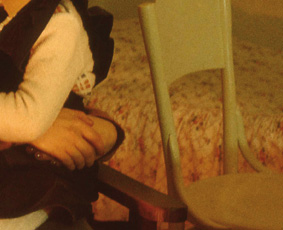
Ana Opalic
PISMO
Video | dv | color | 7:22 | Croatia | 2009
Mario Elias Opazo Cartes
Catalogue : 2009PIEL | 0 | dv | color | 5:22 | Colombia, Algeria | 2008
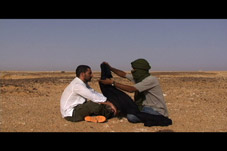
Mario Elias Opazo Cartes
PIEL
0 | dv | color | 5:22 | Colombia, Algeria | 2008
VIDEO REALIZADO EN LOS CAMPAMENTOS DE REFUGIADOS SAHARAUIS EN EL SUR OCCIDENTE DE ARGELIA, MUESTRA DOS ACCIONES PERFORMATIVAS REALIZADAS EN EL DESIERTO DEL SAHARA, LA PRIMERA ES UN RELATO DEL AUTOR EN EL QUE DESCRIBE COMO SU MADRE PROTEGIA SU VIDA ANVOLVIENDOLO EN LA BANDERA DE CHILE DURANTE EL GOLPE DE ESTADO DEL GENERAL PINOCHET, LUEGO PROCEDE A CUBRIR SUS OJOS CON LA BANDERA DE SU PAIS, LA SEGUNDA ACCION CONSISTE EN LA IMPOSICION DEL TURBANTE POR PARTE DE UNO DE LOS GUERREROS SAHARAUIS , AL AUTOR PARTICIPA DE ESTE RITUAL CONFIRMANDO SU APOYO Y LUCHA POR LA CAUSA SAHARAUI. ESTE VIDEO FORMA PARTE DE UN PROYECTO MAYOR QUE REUNE VARIAS ACCIONES Y VIDEOS INCLUYENDO UN LARGO METRAJE QUE SE ENCUENTRA EN ETAPA DE EDICI´ON Y QUE SE CONCLUIR´A EN EL MES DE DICIEMBRE DE ESTE AÑO. ESTAS ACCIONES PROPONEN AL CUERPO COMO UN ACTOR POLITICO DENTRO DE UNA OPERACION MICRO POLITICA Y SIMBOLICA, SON ACCIONES DE RESISTENCIA Y SEÑALAMIENTO EN EL PAISAJE , VISTO ESTE COMO ESCENARIO POLITICO, INTENTAN CORROER Y ATACAR LA INJUSTICIA DE NACIONES PODEROSAS SOBRE OTRAS MENORES.
Mario Opazo Tomé, Chile 1969 Artista plástico y realizador audiovisual de origen chileno, vive y trabaja en Bogotá, es profesor de la Universidad Nacional de Colombia. Actualmente su obra se orienta hacia las posibles relaciones entre lo preformativo, lo audiovisual y la palabra escrita. Su ánimo interdisciplinario lo ha llevado a proponer productos estéticos ?des generados? y fluctuantes entre el contenido y el medio, entre la narrativas tradicionales y experimentales, que ubican su lugar de configuración más en la conducta creativa que en las destrezas y habilidades disciplinares, acudiendo a una posible subversión de los límites y particularidades de los lenguajes estéticos. Diseña acciones de resistencia y gestos micro políticos que develan su posición y punto de vista crítico frente al mundo contemporáneo. Ha participado en importante eventos como la 50º Bienal Internacional de Arte de Venecia, el Premio al Arte Latinoamericano en el MOLAA, California EE.UU., donde obtuvo el Primer Premio, el Reencontres Internacional de Cine y Video Experimental en el Centro Georges Pompidou en París y en el Museo Nacional Reina Sofía en Madrid entre otros, a parte de exhibir su trabajo en exposiciones individuales y colectivas dentro y fuera del país, ha sido nominado a distintas becas y premios de creación, entre ellos se destacan la Nominación a la Beca Guggenheim por Paulo Bruscky en el año 2000 y al Premio Luis Caballero en el 2008. Se destaca su exhibición individual ?Territorio Fugitivo?, inaugurada en marzo del 2008 en Santiago de Chile. Entre otros premios importantes, ha recibido el Primer Premio en el 36º Salón Nacional de Artistas en Colombia, El Primer Premio en el salón de Arte Joven, en el Salón de Arte Bidimensional, en el Salón Kent Explora de la British American Topbaco e innumerables menciones y reconocimientos a su trabajo.. En este Momento la Curadora y académica Natalia Gutiérrez adelanta la escritura del libro dedicado a su trabajo, titulado, ?Mario Opazo, Boomerang? Algunas de sus últimas obras se concentran en exploraciones audiovisuales, desde el video arte hasta producciones más cercanas a lo documental y la ficción, cuenta con una videografía que se destaca por su tono poético y político, poniendo de relieve las solitarias pulsiones del hombre actual y el estado de desamparo del mundo contemporáneo.
Catalogue : 2008Olvido de area | Experimental video | dv | color | 8:0 | Colombia | 2006
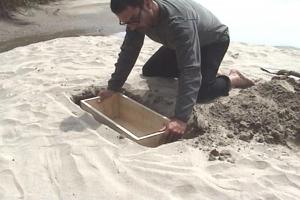
Mario Elias Opazo Cartes
Olvido de area
Experimental video | dv | color | 8:0 | Colombia | 2006
Video action based in the gesture of burry, and takes out again a crate, during the process; the crate is filling in the inner with sand and on it, is writing the world OLVIDO. The action was motivated after to go to a town carnival, where the childrens wear a die angels costume and they loaded on their shoulders boxes similar to a coffin. During the ?holiday? precession, the childrens paraded in the town streets in obedient attitude, in slow step, with black clothes and with the white face (they spread in their faces plane flour), with they, the mothers cried in choir.
Chilean visual artist and audiovisual producer, who lives in Colombia. Universidad Nacional de Colombia Teacher He had participated in more than 100 exhibitions in Colombia and other countries, his work is emphasized since 1991. Recognitions like: Frist prize in the XXXVI Salón Nacional de Artistas in 1996, Nominated to the Guggenheim Grant by the conceptual brasilean artist Paulo Bruscky in 1999. He had representated to Colombia in the 52ª Internacional Art Biennial of Venice, Italy 2007 with his proyect "Fugitive Territory". And this year he won the first prize to the latin american art MOLAA in USA.
Catalogue : 2008Triptico del odio | Experimental film | dv | color | 8:0 | Colombia | 2007
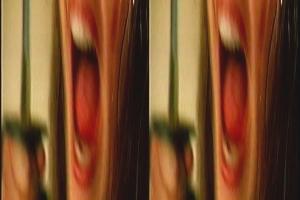
Mario Elias Opazo Cartes
Triptico del odio
Experimental film | dv | color | 8:0 | Colombia | 2007
?Light, Time and space exercises. A way to evacuate narratives to investigate in the pure structures of the image, the edition instrument as only apparatus, like space that betrays the system operator as an actor of the image, the edition process in relation to the preformative and the apropiation gesture, investigating in the relations etween cine and video "
Chilean visual artist and audiovisual producer, who lives in Colombia. Universidad Nacional de Colombia Teacher He had participated in more than 100 exhibitions in Colombia and other countries, his work is emphasized since 1991. Recognitions like: Frist prize in the XXXVI Salón Nacional de Artistas in 1996, Nominated to the Guggenheim Grant by the conceptual brasilean artist Paulo Bruscky in 1999. He had representated to Colombia in the 52ª Internacional Art Biennial of Venice, Italy 2007 with his proyect "Fugitive Territory". And this year he won the first prize to the latin american art MOLAA in USA.
Els Opsomer
Giorgio Orbi
Catalogue : 2019INTHEMOUNTAINS | Documentary | 4k | color | 26:26 | Italy | 2018
Giorgio Orbi
INTHEMOUNTAINS
Documentary | 4k | color | 26:26 | Italy | 2018
“Mountains look so beautiful that once you start looking at them you can’t stop. A glance lasts only a moment but it takes part of a whole metamorphosis” INTHEMOUNTAINS ponders over the role of the artist and the evolutionary dialogue with the mountain and its landscape; an essential role that welcomes the transformations of the contemporary mountain through the collective memory of underground dance music. Monte Pelmo is the starting point of the artist's journey of research. It was climbed by the first President of the London Alpine Club John Ball and witnessed the birth of alpinism in the Dolomites. The structure of the documentary has been progressively built through the vocal contributions of an on-air radio program over one year of broadcast on Radio Cortina, where Orbi invited guests in conversations about the landscape. Among many and different radio contributors, an artist Luigi Ontani, an astrologer Marco Pesatori, an editor Valerio Mannucci, an alpinist Pietro dal Prà and an architect Antonio de Rossi were selected by Orbi to feature as main characters in the documentary. The title of the project comes from “What the Thunder Said” the fifth section of The Waste Land by T. S. Eliot.
Giorgio Orbi (1977) is an Italian artist born in Rome. Before beginning to regularly exhibit his work in art spaces, he took part in the Italian underground music and art creative scene of the nineties. He is a writer, musician, filmmaker, photographer, visual artist and alpinist. In his work, Orbi has often related, through different media, with the concept of the mountain as both a natural and cultural “presence”.
Marika Orenius
Catalogue : 2007Polkuja | Video installation | dv | color | 7:17 | Finland, Sweden | 2005
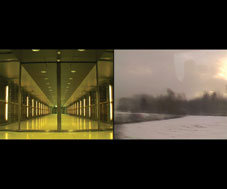
Marika Orenius
Polkuja
Video installation | dv | color | 7:17 | Finland, Sweden | 2005
"Paths" is about societal, mental and psychological structures that control life. It emphasizes the unconscious and dreams as counterweights to the parameters of society through spaces without organized supervision like home, nature, or sleep.
Marika Orenius studied at the Academy of Fine Arts of Helsinki and Gothenburg, and at ENSBA, Paris. Orenius works with film, video, photos, performances, and new media.
Matthieu Orlean
Catalogue : 2013RESIDENCE DES LIMITES | Video | dv | color | 22:0 | France | 2011

Matthieu Orlean
RESIDENCE DES LIMITES
Video | dv | color | 22:0 | France | 2011
Résidence des limites est un film fait à partir de photographies numériques prises depuis 2005 à travers le monde, et en particulier à travers le cinéma, pour le cinéma, autour du cinéma. Les photographies sont spontanées, jamais mises en scène, mais leur agencement, leur montage dessine un nouvel axe de lecture, une infra-fiction, les signes d?un récit intime et exporté, exposé au regard de celui qui le découvre. C?est aussi un film sur le temps qui passe, les visages qui se métamorphosent, les coïncidences qui existent et qui se manifestent au bord du cadre. Et que la bande son rend visible. Une musique patchwork qui jaillit du début à la fin, sans discontinu, mix du cinéma tel qu?il existe (des symphonies cinétiques) et du cinéma en train de se faire (des ébauches sonores venues d?horizons différents, à peine sortis du Nagra, sans traitement). Résidence des limites est un peu la rencontre du cinéma des mythes et du cinéma en train de se faire. Matthieu Orléan Septembre 2012
Matthieu Orléan est collaborateur artistique à La Cinémathèque française, chargé des expositions temporaires depuis 2003. Il a été le commissaire des expositions ¡ Almodóvar Exhibition ! (2006) et Dennis Hopper et le Nouvel Hollywood (2008). Il a également co-dirigé les ouvrages Renoir/Renoir, ¡ Almodóvar Exhibition !, L?Image d?après (Prix du plus beau catalogue 2007) et Dennis Hopper et le Nouvel Hollywood. Il écrit depuis 1998 sur le cinéma et les arts plastiques pour la presse (Cahiers du Cinéma, Trafic, Vertigo, Synopsis, Purple, Numéro) et pour différents ouvrages (Chantal Akerman, Autoportrait en cinéaste et Raymond Hains, J?ai la mémoire qui planche aux éditions du Centre Pompidou ; Trésors Publics, 20 ans de création dans les Fonds régionaux d?art contemporain aux éditions Flammarion). En 2011, sort aux Editions de l??il son ouvrage consacré au cinéaste Paul Vecchiali, La Maison cinéma. En 2007, il a co-réalisé avec Christian Merlhiot Des Indes à la Planète Mars, présenté en Compétition officielle au FID et sorti en salles à Paris en avril 2008. Il a écrit les scénarios des deux derniers films de Philippe Terrier-Hermann : en 2009, La Dérive (sorti en salles à Paris), et en 2012 La Tétralogie américaine (présenté au festival Hors pistes).
Uriel Orlow
Catalogue : 2026Forest Futures | Experimental film | 4k | color | 28:0 | Switzerland, Italy | 2024
Uriel Orlow
Forest Futures
Experimental film | 4k | color | 28:0 | Switzerland, Italy | 2024
Forest Futures is a poetic and thought-provoking film that visits ancient forest ecosystems from the earth’s past, imagines future forests in the face of changing climate and shows the forest as a multi- species school, where children practice more-than-human co-existence. Forest Futures explores the forest as a site of deep time, ecological transformation, and interspecies learning. Set in the mountainous region of South Tyrol, the film traces a journey from ancient fossilized forests that thrived over 280 million years ago through to speculative visions of future forests in a rapidly warming world. Combining scientific research with imaginative storytelling, the film reimagine the forest as both a teacher and a protagonist.
Uriel Orlow is a Swiss-born artist who lives and works between Lisbon, London and Zurich. In 2023 he was the recipient of the prestigious Prix Meret Oppenheim/ Swiss Grand Prix of Art. Orlow’s work is presented widely in international survey shows including at Dunkerque Triennale, Kochi Biennale, 12th Berlin Biennale for Contemporary Art, Kathmandu Triennale, Manifesta 12, Palermo, 2nd Yinchuan Biennial, 13th Sharjah Biennial, 7th Moscow Biennial , EVA International, Limerick, 2nd Aichi Triennale, Nagoya , Bergen Assembly, Manifesta 9, 54th Venice Biennale and elsewhere. Recent solo exhibitions include Galeria Avenida da Índia, Lisbon (2025); MCBA, Lausanne (2024); Casa da Cerca, Alamada (2022); Kunsthalle Nairs, Scuol (2021); La Loge, Brussels (2020); Kunsthalle Mainz, Germany (2020); Privas Art Centre, France (2019); Les Laboratoires d’Aubervilliers, Paris (2018); Market Photo Workshop & Pool, Johannesburg (2018); Kunsthalle St Gallen (2018) and many others. Orlow’s films been screened at Tate Modern, London; the International Short Film Festival, Oberhausen; Tank.tv; Whitechapel Gallery, London; Locarno Film Festival; Videonale Kunstmuseum Bonn; BFI London; The BBC Big Screen, Manchester; Arnolfini Bristol; Espace Croisé CAC Roubaix; and at the Biennale of the Moving Image, Geneva, and others.
Ed Osborn
Catalogue : 2008Wandering Eye Studies | Experimental video | dv | color and b&w | 5:0 | USA | 2006

Ed Osborn
Wandering Eye Studies
Experimental video | dv | color and b&w | 5:0 | USA | 2006
The Wandering Eye Studies is a series of video and sound pieces generated as part of the development for an interactive video installation entitled Wandering Eye. The installation produces images and sounds from video input gathered by an array of surveillance cameras and explores the visual language of electronic observation. The Studies explores some of the visual transformations brought about by focusing on particular aspects of the video imagery: motion is highlighted or isolated, edges of objects are detected and enhanced, and changes in luminance are used to generate the soundtrack. Though I share many of the typical concerns of the culture of surveillance, my interest here is in showing the lure of the image itself. While being in front of the lens is disquieting, the view from behind it is seductive. The oscillation of experience between the two is one of the most compelling aspects of surveillance imagery in the mediascape, one that draws the eye as it unsettles the mind.
Ed Osborn is a sound and media artist who has exhibited and performed worldwide. His artworks take many forms including installation, sculpture, radio, video, performance, and public projects. They demonstrate a visceral sense of space, aurality, and motion combined with a precise economy of materials. Ranging from rumbling fans and sounding train sets to squirming music boxes and delicate feedback networks, Osborn?s kinetic and audible pieces function as resonating systems that are by turns playful and oblique, engaging and enigmatic. Osborn has performed and exhibited at ZKM (Karlsruhe, Germany), the singuhr-hörgalerie (Berlin, Germany), the Berkeley Art Museum (Berkeley, CA), Yerba Buena Center for the Arts (San Francisco), Artspace (Sydney, Australia), Sonambiente Festival (Berlin, Germany), the Museum of Applied Arts, (Helsinki, Finland), Galerie DARE-DARE (Montréal, Quebec), LACE (Los Angeles, CA), MassMOCA (North Adams, MA), the Institute of Modern Art (Brisbane, Australia), the Auckland Art Gallery (Auckland, NZ), and the Sonic Arts Research Centre (Belfast, Northern Ireland). He has received grants and residencies from the Guggenheim Foundation, the Creative Work Fund, Arts International, and the DAAD Artists-in-Berlin Program. He is represented by the Catharine Clark Gallery in San Francisco and Galerie Haferkamp in Cologne. He is Assistant Professor of Media Art at the University of California at Santa Cruz and will join the faculty of the Visual Art Department of Brown University in 2008.
Yana Osman, Anton Khamchishkin
Catalogue : 2026Pwéra úsog | Experimental doc. | mov | color and b&w | 19:50 | Afghanistan, Russia | 2025
Yana Osman, Anton Khamchishkin
Pwéra úsog
Experimental doc. | mov | color and b&w | 19:50 | Afghanistan, Russia | 2025
Pwe?ra u?sog (2025). 19 min dir. Yana Osman, Anton Khamchishkin In 1945, in Paris, the Women’s International Democratic Federation (WIDF) was founded. According to historian Francisca de Haan, it was “the largest and probably the most influential international women’s organization of the post–World War II era.” Today, assessments of the organization’s legacy remain contested. Some scholars, citing reports from the FBI and the House Un-American Activities Committee, describe WIDF as a communist attempt to manipulate women. Others view it as a movement advocating for women’s rights, and researchers like Elizabeth Armstrong note WIDF’s role in anti-colonial and anti-racist struggles led by women in Asia, Africa, and Latin America. In 1987, during the Perestroika era, WIDF organized the World Congress of Women in Moscow, under the slogan: “Toward 2000 — Without Nuclear Weapons! For Peace, Equality, Development!” The congress brought together 2,800 women from 150 countries. Among them, there was the protagonist’s grandmother, an interpreter who collected words from global conversations that had no equivalents in other languages. Revisiting her notes, archival footage, and sites of official delegations, the protagonist is guided by these fragments to a question: what words can capture the present, when language itself slips away, dissolves, and borrowed slogans drown out one’s voice?
Yana Osman, Anton Khamchishkin (Afghanistan, Russia) — artists and filmmakers. Work with gaps in storytelling, filling in the unsaid and uncovering narratives suspended between real and imaginary, facts and speculation. Their films were selected at Hong Kong Film Festival, DOK Leipzig, Slamdance, Rencontres Internationales Paris/Berlin, as well as supported by CNC, Cité Internationale des Arts, Usage du Monde au 21ème siècle, Institut Français, among others.
Yana Osman, Anton Khamchishkin
Catalogue : 2025Shared Univers | Video | hdv | color | 15:0 | Afghanistan, Russia | 2024

Yana Osman, Anton Khamchishkin
Shared Univers
Video | hdv | color | 15:0 | Afghanistan, Russia | 2024
This is a poetic contemplation on the state of the world, as well as a reflection of the times in the authors' homeland, when under the influence of censorship they are forced to seek an alternative language to discuss significant issues. In this work, diverse realms intertwine: the game setting, ancient Greek tragedy, social utopia, and our contemporary era. It is a shared universe, enriched by the voices of many authors.
Yana Osman, Anton Khamchishkin (Afghanistan, Russia) Filmmakers and audiovisual artists. Their artistic practice, including video, photography, sound, performance, and poetry, delves into how personal, social, and political documentary contexts become anentry point to the fantasy worlds we live. Their works have been exhibited at festivals, museums, and contemporary art spaces in Armenia, China, Finland, Germany, Hong Kong, India, Ireland, Italy, Kazakhstan, the Netherlands, Russia, Turkey, and even Antarctica, as well as in France, supported and showcased by CNC, Cité Internationale des Arts – Paris, Usage du Monde au 21ème siècle, Maison Européenne de la Photographie – Paris, Institut Français, Théâtre Nouvelle Génération (TNG) – Lyon, among other.